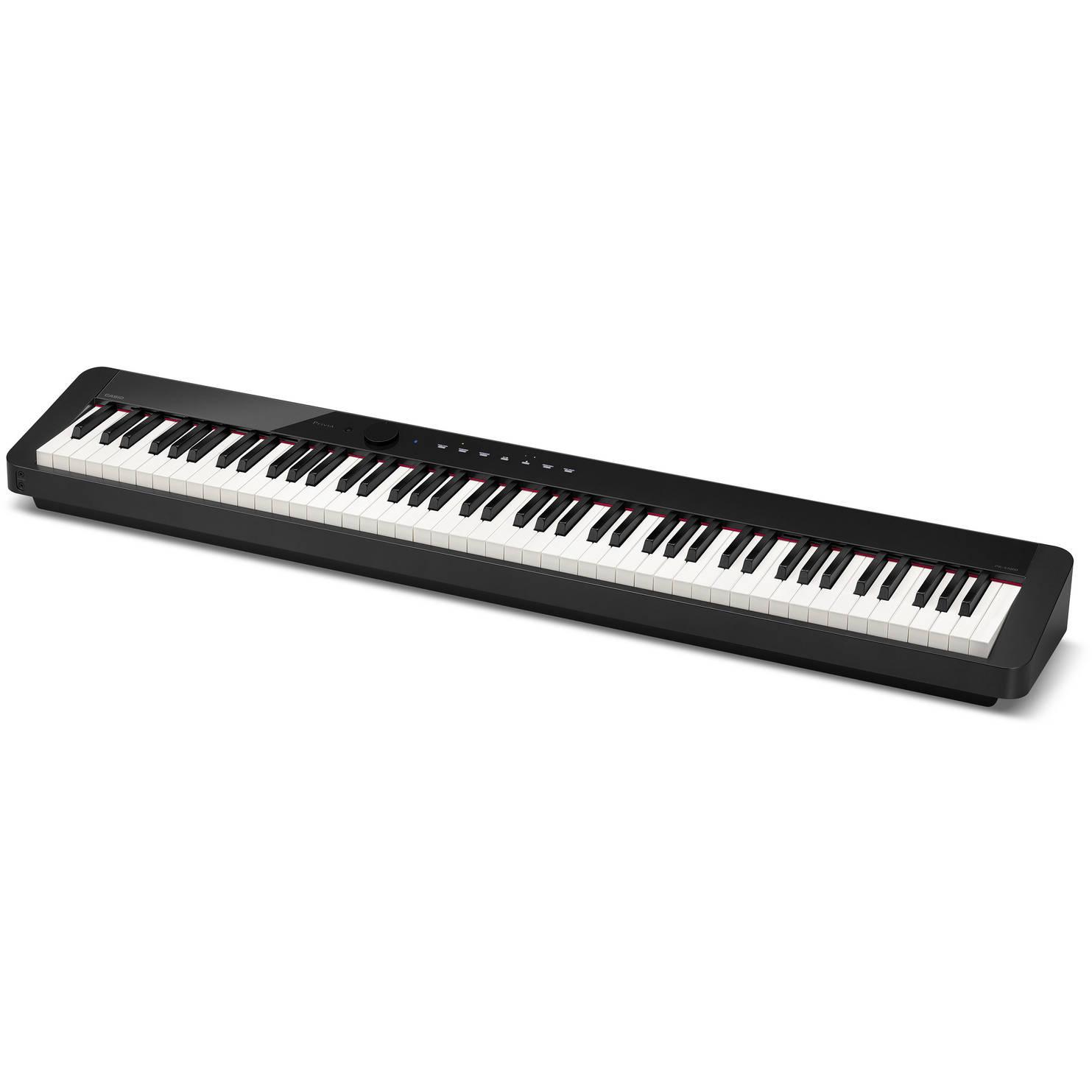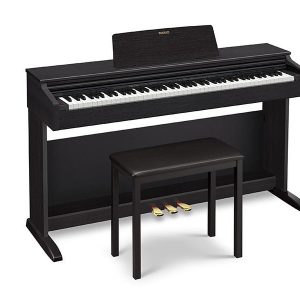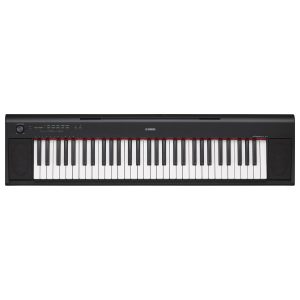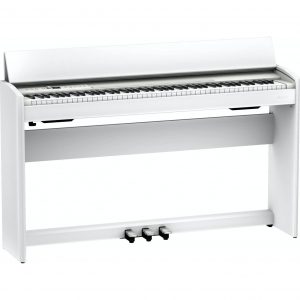Casio PX-S1000
$369.99
The Casio PX-S1000 piano offers a sleek design, authentic piano sound, and advanced features to enhance your playing experience.
Compare
Description
The Casio PX-S1000 digital piano is a remarkable musical instrument designed for players who demand excellence. The piano features a wide range of features that make it perfect for performing, practicing, or recording. From its stylish design to its advanced features, the PX-S1000 is a piano that delivers both quality and performance in one package.
Design
The PX-S1000 has a modern and sleek design that is both aesthetically pleasing and functional. It has an 88-key keyboard that is compact, lightweight, and slim. The compactness of the keyboard makes it easy to transport, while its slim nature ensures it takes less space in your living room or music studio. The lightweight nature makes it easy to move and set up, so you can play your music from anywhere.
Sound
The Casio PX-S1000 has a sound system that has been engineered to produce the best quality sound. With its powerful sound system and key action, the piano delivers the perfect balance of tone and resonance. The piano has 18 high-quality tones that can be selected easily, allowing you to produce sounds that match your style and mood.
Action
The PX-S1000 has an impressive key action that provides a natural feel while playing. The touch response is smooth, and you can adjust it to your desired touch sensitivity. This feature helps you to play more expressively, therefore improving your overall performance.
Connectivity
The Casio PX-S1000 has a range of connectivity options that can connect to your computer, tablet, or smartphone. It comes with Bluetooth, so you can connect it to your device and play along with your favorite music or learn new songs. The piano also has USB connectivity, allowing you to connect to your computer and use it as a MIDI controller.
Conclusion
The Casio PX-S1000 piano is the perfect musical instrument for players who want an advanced, compact, and portable piano. It delivers quality, versatility, and performance in one package. Its advanced features, such as Bluetooth and USB connectivity, make it the ideal piano for composing, recording, or practicing. When you consider the quality of the sound, the key action, and the design, the Casio PX-S1000 is an excellent piano that is worth every penny. If you want to take your music performance and practice to the next level, consider getting the Casio PX-S1000 piano.
Casio PX-S1000 properties
| Product name |
PX-S1000 |
| Brand |
Casio |
| Type |
Keyboard Instruments |
| Keyboard Instrument |
Stage and Digital Piano |
| Keys |
Yes |
| Number of Keys |
88 pcs |
| Key Functions |
Adjustable Keys, Split, Touch Sensitive, Weighted Keys |
| Pre-Programmed Songs |
Yes |
| Pre-Programmed Sounds |
Yes |
| Pre-Programmed Effects |
Yes |
| Speakers |
Yes |
| Connections |
3.5mm (Aux), 6.3mm (1/4″RTS), USB |
| Colour |
Black |
| Power Supply |
Electrical Cable to Wall Socket |
Frequently Asked Questions:
Can you help me set up my Casio PX-S1000 for the first time?
Certainly! Here are the steps to follow:
1. Unbox your Casio Privia PX-S1000: Take all the accessories out of the box, including the power adapter, music stand, and any other items provided. Make sure you have everything before proceeding with the setup process.
2. Connect the power supply: Locate the power port on the back of your Casio PX-S1000 and connect the included AC adapter to it. Then plug the other end of the adapter into an electrical outlet. The power indicator light should turn on, indicating that your keyboard is receiving power.
3. Turn on your Casio Privia: Press and hold the "Power" button located on the top-left corner of the keyboard until the display turns on. This may take a few seconds.
4. Adjusting the settings: Use the buttons labeled "Function 1," "Function 2," and "Function 3" to navigate through the settings menu. You can adjust various parameters like volume, touch sensitivity, and more using these keys.
5. Connect external devices: If you want to connect your keyboard to other devices such as a computer or another instrument, use the provided MIDI in/out ports on the back of the unit. Simply plug in the appropriate cables, and follow any additional setup instructions provided by your software or hardware.
6. Install the Casio Chordana Play app: To access more features and learning tools, download the free Casio Chordana Play app from the App Store or Google Play. Connect your device to the keyboard using a USB cable (not included), then follow the on-screen instructions to pair them together.
7. Place the music stand and pedals: Attach the included music stand to the top of your keyboard if desired, and place any optional footpedals near your feet. Make sure there is enough space around your instrument for comfortable playing.
8. Practice! Start exploring the different sounds and functions available on your Casio Privia PX-S1000. Experiment with the various presets, create custom settings, and try out some of the built-in lessons to improve your skills.
How does the Tri-Sensor Scaled Hammer Action Keyboard II found on the Casio PX-S1000 differ from that of a typical digital piano?
The Tri-Sensor Scaled Hammer Action Keyboard II found on the Casio PX-S1000 is different from that of a typical digital piano in its use of three sensors for each key. In contrast, most digital pianos have only one or two sensors per key. This additional sensor technology allows for greater accuracy and realism in touch and response, as it can detect the precise amount of force and speed applied to each key, simulating the feel of playing an acoustic grand piano.
How does the Hybrid Sound Source technology in the Casio PX-S1000 deliver a rich, vibrant sound that rivals that of a grand piano?
The Hybrid Sound Source technology in the Casio PX-S1000 is a combination of advanced digital sampling and modeling techniques. It uses multiple layers of stereo samples from high-quality concert grand pianos, captured at different velocities and recorded in various environments to provide a rich, vibrant sound. The technology also includes Casio's proprietary AiR (Acoustic and Intelligent Resonator) system, which simulates the complex resonances that occur within a grand piano, resulting in a more realistic and immersive playing experience. Overall, the Hybrid Sound Source in the PX-S1000 delivers a level of sound quality that rivals that of a grand piano, making it an excellent choice for pianists who demand the most authentic and expressive sound possible.





Evan O’neil –
The Casio PX-S1000 has been a fantastic purchase for me since I bought it last summer. I would rate it a solid 4 out of 5.
In terms of gender inequalities, it’s important to acknowledge that the world of musical instruments has historically been male-dominated. However, the Casio PX-S1000 is a great example of a product that can help bridge this gap. By offering a sleek and modern design, it appeals to a wider range of individuals, regardless of gender. This inclusivity is crucial in breaking down barriers and encouraging more women to explore their musical talents.
When it comes to the brand aspect, Casio has established itself as a reliable and reputable manufacturer in the music industry. Their commitment to quality and innovation is evident in the PX-S1000. This digital piano combines the convenience of a stage piano with the versatility of a digital instrument.
One of the standout features of the Casio PX-S1000 is its slim and lightweight design. It is incredibly portable, making it easier for musicians to transport it to gigs, rehearsals, or even practice sessions. This aspect is especially beneficial for female musicians who may find it more challenging to carry heavier instruments.
Additionally, the technical aspects of the PX-S1000 make it a unique and impressive digital piano. It boasts an advanced AiR (Acoustic and Intelligent Resonator) sound engine, which produces a rich and authentic piano sound. The 88-key scaled hammer action keyboard provides a realistic piano-playing experience, further enhancing the instrument’s overall quality.
The Casio brand name itself carries weight in the music industry. Known for their reliability and durability, Casio instruments have garnered a strong reputation among musicians. Choosing the PX-S1000 was an easy decision for me due to the brand’s track record and the positive reviews I had read about this particular model.
In conclusion, the Casio PX-S1000 is a remarkable digital piano that not only excels in its technical aspects but also contributes to breaking down gender inequalities in the music industry. Its inclusive design, lightweight portability, and impressive sound engine make it a valuable instrument for musicians of all genders. The Casio brand’s reliability and reputation further solidify the PX-S1000’s appeal as a top choice for anyone in search of a high-quality stage and digital piano.